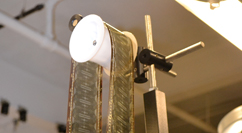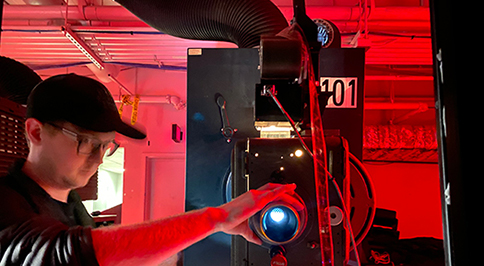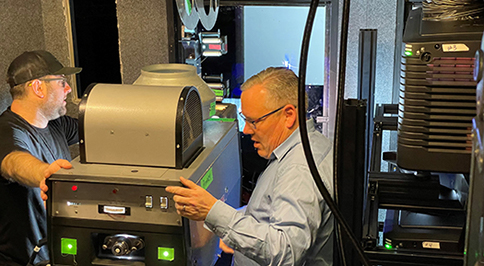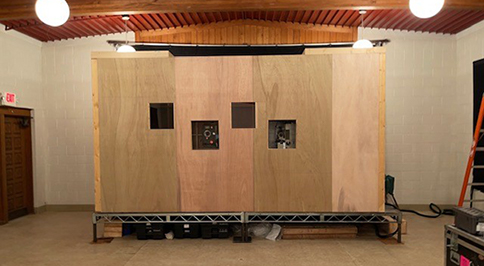
Oppenheimer 70mm Release ::
Universal Studios Chooses Boston Light & Sound® (BL&S) for
North American Release in 70mm
When they set out to bring Christopher Nolan’s Oppenheimer to 70mm screens around the country, Universal Studios knew there was one company for the job: Boston Light & Sound® was uniquely positioned to manage the complex job. Having worked with Nolan’s team on the 70mm release of Dunkirk and having previously worked on the release of The Hateful Eight, they knew the BL&S team had the technical acumen, equipment and background to pull this off.
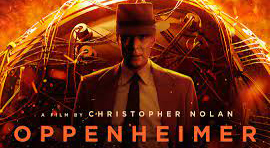
The work began during production, with BL&S providing a custom dailies system to make it easy for the movie director and the director of photography to quickly view footage from the previous day, despite being in a remote location. The movie was shot on location directly onto film, so BL&S designed and built a custom dual-projector system to enable viewing of 70mm and 35mm transfers of IMAX footage shot the day before.
During post-production, the filmmakers wanted to screen the 70mm film on a large screen. To do so, BL&S installed a special electronic 70mm Kinoton studio projector connected to a ProTools sound station at a Hollywood multiplex. The ProTools was used to playback sound in sync with the projector. The unique system interfaced with the theatre’s existing Dolby sound system while still maintaining the ability for the theatre to play standard digital cinema content at the push of a button.
For the movie release, BL&S commissioned the specialty equipment and projection expertise necessary to run the film at locations across the country. The largest logistical challenge was staffing 71 locations with projectionists. Due to the unprecedented success of Oppenheimer, what was originally planned as a two-week run turned into a 13-week run. Keeping the theatres staffed with trained, knowledgeable professional projectionists was a huge undertaking.
In addition, the BL&S team provided specialty lenses and refurbished DTS systems, and ensured all the right equipment was set up at each theatre. They then developed a method to interface DTS playback with the latest Dolby Atmos systems while retaining the ability to run DCP content in Atmos seamlessly. This involved reverse engineering and developing a custom circuit board for switching between digital projection and DTS playback from film in Dolby Atmos-equipped theatres.
The team also offered print make-up services, assembling bulk film reels from Fotokem and assembling them on ready-to-play film prints. Throughout the run, BL&S provided around-the-clock technical support to ensure things ran smoothly.
The success of the project was beyond expectations. The studio and audiences alike were thrilled with the result.
Dunkirk Premiere ::
Boston Light & Sound® helps revive Super Panavision 70 for projecting Christopher Nolan’s visionary WWII film
When director/writer/producer Christopher Nolan set out to create his film chronicling the mass evacuation of allied troops from the beaches of Dunkirk, he insisted on filming in IMAX 70mm. As he told an Irish Times reporter, “70mm is the most incredible way to tell a large-scale story. The audience really gets the benefit of that large canvas, that depth of colour, that heightened resolution.”
Since the dimensions of the 70mm film are larger than standard 35mm,
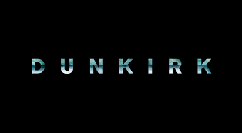
it changed the look and experience for moviegoers – giving them a more immersive experience than even 4K digital playback. Warner Brothers embraced Nolan’s plan to release Dunkirk as a cinematic event. The studio funded the largest rollout of a 70mm film feature in 25 years, releasing the film in expansive 70mm at 125 theatres internationally.
Reviving the craft of 70mm film projection
It was going to take a special team of presentation experts to pull off Nolan’s vision, and for this, Warner Brothers turned to Boston Light & Sound (BL&S). Having successfully managed The Hateful Eight presentation and road show in Ultra Panavision 70, BL&S was eager to bring back this wide format to moviegoers. In high definition 70mm, “The movie is stunning,” said Project Manager Jan Jones of Boston Light & Sound. “Making sure the movie is seen as the director intended is a craft in and of itself.”
“70mm brings a presence and a power to the film,” said Boston Light & Sound co-founder Chapin Cutler. “It gave the film more visibility and specialness than it otherwise would have had. Presenting this film was more than a project for us. The results really meant something for all of us involved in this rollout.”
“The people who trained me to be a projectionist in the ‘60s had come out of the silent era when you hand-cranked the film. They were present when sound first came to the audience. For me, my company, and my partner Larry, it is part of our responsibility to continue practicing the craft and furthering the technology that was so important to us when we started our careers. This is a mission and a legacy for us all that extends beyond the bottom line.”
Coordinating resources on a massive scale
Presenting Dunkirk in Super Panavision 70 required coordinating a wealth of resources – from finding 90 qualified film projectionists, to refurbishing projectors that had sat idle for more than a year. The project involved five phases:
Phase 1: Surveying 70mm film equipment in 83 locations in a two week time span. This involved assembling 10 crews of technicians to visit each location to check the condition of the sound system, projector, and platter. All the information gathered from the surveys was compiled to prepare for Phase 2 – Service and Alignment.
Phase 2: Servicing of 70mm film equipment in 65 locations in a three week time span. This also included coordinating equipment moves requested by theatre chains. In 12 locations, complete reinstallations were required due to auditorium moves and refurbishments; in seven venues around the country, this needed to be accomplished in the seven days directly ahead of the Dunkirk release date. This involved dispatching technicians, knocking holes in walls for projection ports, building platforms, and coordinating all the required efforts with both the exhibitor and the Warner Brothers management team. This also meant coordinating with construction teams, electrical contractors, and other trades working at locales across the country.
Phase 3: Assembling a facility and a team of experts to create the 70mm prints and coordinating their transport to each theatre location. The print facility took 10, 10-minute film elements along with two previews and built them into one huge reel containing the entire film presentation. The facility was located at the DeLuxe Laboratories facility in Burbank, CA, just minutes from FotoKem, where all the film prints were struck. Each roll of print materials had to be logged in when received, tracked, and accounted for throughout the process. The staff then coordinated shipping the assembled prints to the theatre locations, where film was loaded onto platters used to hold the completed Dunkirk film assembly for presentation. View video: “A Day in the Life of a 70mm Print”
Phase 4: Hiring 90 projectionists to run the film at theatres across the country – and bringing in even more staff when Warner Brothers decided to extend the run of Dunkirk for an additional two-week run in several locations. “Working with the projectionists was fantastic,” Jan said. “They’re an enthusiastic group who love what they do. A lot of them had run 70mm systems early in their careers and actually took vacations from their current jobs to come and have this experience of bringing 70mm to new audiences.”
“Boston Light & Sound’s devotion to film projection is second to none,” said projectionist Mark Davenport. “For them to pull this off and for me to be a part of it was a thrill. How lucky can I be?!”
Phase 5: Supporting theatres virtually 24x7 during the film run. The BL&S team provided phone and field support to the theatres around the clock for the entire run of Dunkirk. Several technicians were on standby around the country for immediate dispatch should technical problems arise that could not be resolved with phone conferencing. Parts and replacement components were prepackaged and ready for immediate shipment in case an immediate replacement was needed in the field.
Throughout the project, BL&S worked closely with each theatre and exhibitor. They understandably had questions along the way. “There’s a learning curve that goes into the exhibition of film,” said Cutler. “It was important to us that [the theatre owners and staff] not only understood what we were going to do, but that we were respectful of their business and their property. I’m pleased to say that Jan’s team got many compliments from exhibitors for their thoughtfulness and for their fast response. This team orchestrated and coordinated everything, working closely with theatre staff, projectionists, venue technical crews, shippers, and the ‘platter farm’ print assembly crew to make sure everything ran as smoothly as possible.”
Sharing the experience of 70mm
“The run was fabulous,” said Cutler. “There is a physiological difference to watching a movie on film than in its digital counterpart. I believe it’s warmer and more engaging. It’s a whole different sensation than sitting down and watching a screen in your home. There’s a great deal of interest in getting people into theatres. Releasing a film like Dunkirk in Super Panavision 70 is a way for studios to differentiate their product and make the experience of seeing films in theatres stand out as something truly special.”
Audiences were thrilled with the release. Some projectionists reported that patrons wanted to see the film projector, and some applauded the projectionists when they showed up at the window. “They knew there was a person making this happen, and that made it feel unique,” Cutler said.
Making a personal connection
For many theatregoers, Dunkirk truly brought home the sacrifice made by the people involved in the historic event, many of whom were civilians who came in small vessels to save their fellow men. “Every time you saw a ship blow up, you felt it in your heart for each and every one of those men on the beach or who went down with their ship,” said Cutler. “There was something of this movie that had a more personal feel than watching a typical war movie. I truly believe that the quality of the storytelling was enhanced with the 70mm film experience.”
Creating a SHOW
On the heels of this success, there is much buzz in the industry about new films being planned – and epic classics being remastered – in 70mm. “When Larry and I started our company 40 years ago, we set out to take the craft we had learned and carry it to an extreme,” said Cutler. “For us, there is a significance to the term ‘SHOW’ – as practiced by the Telluride Film Festival. Our goal is to project images as perfectly as we can, with the highest quality sound, whether it’s digital or 70mm or Super 8. Being able to present Dunkirk in Super Panavision 70, which has the highest resolution of any standard film or digital cinema format, and to make it perform at a level that exceeds how it was done 25 years ago, that is and continues to be, our goal.”
Learn more about BL&S’s 70mm Services
News and Extras ::
Q&A with Dunkirk projectionist Mark Davenport
Releasing the gripping WWII film Dunkirk in 70mm took more than sourcing, refurbishing, and installing projection equipment. It also involved hiring projectionists to run the film at more than 125 theatres across the country. We sat down with one of the projectionists, Mark Davenport, to hear about his experience working on the Dunkirk film premiere with BL&S.
Video
Behind-the-scenes DVD Extra of ‘Dunkirk’ on 70mm film: “70mm is the most incredible way to tell a large-scale story,” says ‘Dunkirk’ director/writer/producer Christopher Nolan. Watch footage of the movie and find out how the 70mm film moves through the print make-up, from processing to editing to the theatre.
News
August 2017
July 2017
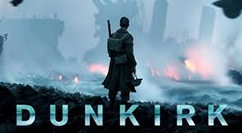
An extraordinary moviegoing event
“We are so proud that Christopher Nolan’s epic Dunkirk had the distinction of being the largest 70mm theatrical engagement in 25 years. However, we could never have achieved this mark without Chapin Cutler and the team at Boston Light & Sound working hand-in-hand with us every step of the way. On behalf of everyone at Warner Bros. Pictures, I want to thank them for everything they did to help make Dunkirk an extraordinary moviegoing event.”
The Hateful Eight ::
Boston Light & Sound® Brings Tarantino’s New Western to Theatres in Glorious Ultra Panavision 70mm
When film producer Shannon Macintosh approached Boston Light & Sound (BL&S) to provide 70mm film dailies for Quentin Tarantino’s The Hateful Eight, little did they know this would evolve into the largest project they’d ever tackled: Presenting a movie in the grandeur of 70mm film in 100 theatres across North America.
A reason to return to the theatre
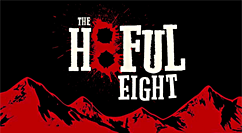
In creating The Hateful Eight, Mr. Tarantino made the artistic decision to shoot his new western in Ultra Panavision 70 – an optical process that had not been used since the 1960s with the release of the epic film Khartoum. In fact, only ten Hollywood movies were ever produced in this ultra-wide format. Film aficionados are anxiously awaiting the film’s release in Ultra Panavision 70, which will be presented in the style of old cinema roadshows, complete with music and an intermission. This extremely high resolution presentation provides a greater sense of space, capturing both the splendor of the mountains of Telluride, CO and the intimate detail of the interior of “Millie’s Haberdashery” where most of the film takes place.
A movie release on a grand scale
The film’s distributor, The Weinstein Company (TWC), charged BL&S to locate and rebuild 120 projection systems for this project. The 70mm film format had become obsolete with the advent of digital audio and digital cinema systems, though a few very limited releases have happened in recent years. “This endeavor is more than the rediscovery of old technology,” said BL&S Co-founder Chapin Cuter. “It’s a project that required big vision, a lot of strategy, and the participation of many people.” The projectors needed for this unique premiere event had been out of manufacture for at least 15 years.
Preparing the stage
BL&S conducted extensive prep work before working with the 70mm equipment for the project.
- First, BL&S technicians visited the 14 theatres where Interstellar was in release to research its screening process and check the condition of the prints.
- Next, they surveyed about 45 theatres around the country designated by TWC as typical of the types of venues they hoped to eventually equip.
- Then, the BL&S team began a nationwide search for 70mm machines and all the other gear needed for the project. This was no easy task since much of the equipment had been abandoned or destroyed since the advent of Digital Cinema Package content delivery into the exhibition industry.
Designing and manufacturing equipment
BL&S has decades of experience analyzing the mechanical workings of projection systems, optimizing them to get the best performance possible. “For years, we have been working with studios and film directors,” said Larry Shaw, co-founder of Boston Light & Sound. “We know how to make equipment perform to meet their exacting standards. That's one of the key reasons we were well suited to this project.”
Since there weren’t nearly enough working or complete projectors and backup parts in existence for a project of this scope, BL&S:
- Located and remanufactured existing 35/70mm projectors and optimized them for 70mm film only
- Arranged for the design and manufacture of two different anamorphic lenses to widen the film image to Ultra Panavision 70 specifications
- Developed kits to allow 35mm platters to accommodate 70mm film
- Designed, redesigned, or remanufactured 125 different parts, including gears, shafts, sprockets, rollers, and other system components
- Located used 70mm lenses and had them optimized for the best optical performance possible
- Rebuilt xenon lamp consoles, optimizing them for the 70mm release; located and totally refurbished DTS playback systems; brought PTR film cleaner rollers back into manufacture; and developed a custom water chiller needed to keep parts of the projector cool for the best operational performance of the machines
- Contracted for manufacture of new DTS film sound timecode readers; contracted for manufacturing new 70mm splicers; added heat filters to every xenon lamp console to reduce heat and improve the film’s performance during projection
- Had special film reels manufactured and designed transport cases so that the 3 hour and 9 minute film prints could be shipped and ready for presentation, making The Hateful Eight the first such commercial release to use this method of distribution
“It’s been a totally off-the-wall experience,” added Larry. “I’m an engineer and suddenly I’m building parts, and thousands of them at that. We’re used to doing kooky stuff, but this is on a massive scale.”
Reinventing craft of 70mm film projection
Wherever possible, BL&S brought back retired projectionists to help set up and operate the equipment in the field. In addition, BL&S employed film festival crews for other locations. And in some cases, existing cinema staff was trained for the run of the film. To support each projectionist in the field, BL&S developed documentation and video tutorials and provided ongoing technical support.
Solving movie distribution challenges
To support the entire distribution operation, BL&S set up a facility in Valencia, CA to assemble the film prints. Individual film rolls were delivered directly from the film lab, Fotokem to the print make up facility. Each complete print of the movie was comprised of 20 individual rolls of 70mm film, which BL&S ultrasonically welded into one complete roll of film for platter operation with no splices.
“In the entertainment industry, the show must go on,” said Shaw. “If something seems impossible, you ignore that and just do it. We dreamed up new techniques, like converting 35mm film platters to 70mm. Nobody said it couldn’t be done – so we went ahead and did it!”
“Even if they said it was impossible, we’d have done it anyhow,” added Cutler. “We love a challenge!”
Orchestrating multiple trades for installation
Installing the equipment was far from a simple task. Many theatres only had room for their existing digital cinema projector, and some required new projection ports. Local electricians had to run new power service for the additional power needs of the projectors. Projector exhaust was another issue. Some theatres had narrow stairways and no elevator, so just getting the equipment into place was difficult. In one case, a theatre had to have a wall opened to the projection booth area and use a forklift to raise an assembled projector up from the lobby.
Tackling an added challenge
With less than a week to go, BL&S was advised that the project was short about 60 projection staff to operate the systems. Having foreseen this probability, BL&S had already lined up most of the additional crew needed. With only six days to go before opening, they contracted the necessary staff, arranged for their travel and lodgings, and ensured that they were on-site the day before opening.
“In addition, we had shipped ten complete systems to strategic locations around the country to use as a supply of spare components,” said Cutler. “We had about 18 technical staff also located in key areas to provide technical support should the need arise and to support the projectionists as needed.”
Celebrating a successful show!
By Christmas Eve, The Hateful Eight was presented on 70mm in 102 theatres across North America – and it looked stunning. “We were delighted to see how well it went,” said Shaw. “We heard later that people thought pulling this off was improbable. That’s exactly the kind of project for us.”
In the end, the 70mm Ultra Panavision 70 release of The Hateful Eight accounted for a significant percentage of the total domestic gross for the picture. In many cases, patrons asked specifically for the 70mm presentation; this release was a very special event, maybe even a once in a lifetime opportunity to see analog film presentation at its very best.
“This project is a culmination of my 50-year career, bringing it together into one massive project,” Cutler said. “We’ve come full circle. My first job was at a movie theatre in 1964 where I ran My Fair Lady as a 70mm roadshow engagement. The Hateful Eight has allowed us to go back and in some ways reinvent the craft that we were trained into early in our careers. We are very proud and blessed for this experience and the hundreds of people who supported us in this endeavor.”
News and Extras ::
Videos
Watch one projectionist’s timelapse view of The Hateful Eight roadshow from the booth. Andrew Walker notes, “I was lucky enough to be one of the projectionists to work on the 70mm roadshow for The Hateful Eight and this is what I captured during the 59 showings the film over the course of 15 days. The whole thing was quite an experience and it made me appreciate film all over again. Shot with a Nikon D810 using the Kessler TLS system and a Second Shooter.”
70MM of Hateful from Andrew Walker on Vimeo.
News
Check out a selection of the press for BL&S and The Hateful Eight premiere below. Find more news on blsi.com.
January 2016
“‘Let There Be 70mm:’ The Real-life Cinematic Saga Behind Quentin Tarantino’s ‘Hateful Eight’ roadshow” by Peter Weed of MovieMaker.com“Everything Old Is New Again: Theatres go back to 70mm with ‘Hateful Eight’ roadshow” by Rebecca Pahle of Film Journal
“How Tarantino’s Cinematic Gambit With 70mm Paid Off” by Tom Meeks of 90.9 WBUR’s The ARTery
December 2015
“What Six Chicago-area theaters had to do to show Tarantino’s ‘Hateful Eight’” by Patrick M. O'Connell of The Chicago Tribune“How They Put Together ‘Hateful Eight’s’ 70mm Traveling ‘Roadshow’” by Mark Yarm of WIRED
“For Tarantino’s Latest, A Boston Company Resurrects Nearly Extinct Film Projectors” by Andrea Shea and Erin Trahan of 90.9 WBUR’s The ARTery
“A road-ready ‘Hateful Eight’” by Loren King of The Boston Globe
“You'll Never Guess How Much Those Massive ‘The Hateful Eight’ 70mm Prints Weigh” by Zack Sharf of Indiewire.com
“How Weinstein Co. Distribution Chief Erik Lomis Rescued 70mm Cinema For Quentin Tarantino’s ‘The Hateful Eight’” by Anthony D'Alessandro of Deadline Hollywood
“‘The Hateful Eight’: The boys behind the booth” by David Bordwell of Website on Cinema
November 2015
“Boston Light & Sound Works On Tarantino’s ‘The Hateful Eight’” by Jeff Brown of WBZ Channel 4, CBS Boston“Big-screen experience of ‘The Hateful Eight’ built in Boston” by Hiawatha Bray of The Boston Globe.
“Tarantino’s ‘The Hateful Eight’ Resurrects Nearly Obsolete Technology” by Ben Kenigsberg of The New York Times.
September 2015
“35mm Isn't Dead Yet…” on Leonard Maltin’s blog at Indiewire.com.
70mm Technical Support and Film Make-Up ::
Boston Light & Sound® (BL&S) provides studios and directors with 70mm technical support and film make-up for high-profile films, including:
READY PLAYER ONE
JUSTICE LEAGUE
WONDER WOMAN
KONG:SKULL ISLAND
FANTASTIC BEASTS
JOKER
DEATH ON THE NILE
